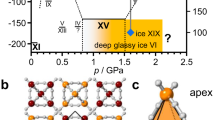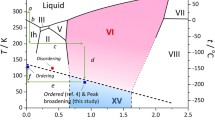Abstract
We discuss a number of examples that demonstrate the value of computational modeling as a complementary approach in the physics and chemistry of ice I h , where real-life experiments often do not give direct access to the desired information or whose interpretation typically requires uncontrollable assumptions. Specifically, we discuss two cases in which, guided by experimental insight, density-functional-theory-based first-principles methods are applied to study the properties of lattice defects and their relationship to ice I h s macroscopic behavior. First, we address a question involving molecular point defects, examining the energetics of formation of the molecular vacancy and a number of different molecular interstitial configurations. The results indicate that, as suggested by earlier experiments, a configuration involving bonding to the surrounding hydrogen-bond network is the preferred interstitial structure in ice I h . The second example involves the application of modeling to elucidate on the microscopic origin of the experimental observation that a specific type of ice defect is effectively immobile while others are not. Inspired by previous suggestions that this defect type may be held trapped at other defect sites and our finding that the bound configuration is the preferred interstitial configuration in ice I h , we use first-principles modeling to examine the binding energetics of the specific ice defect to the molecular vacancy and interstitial. The results suggest a preferential binding of the immobile defect to the molecular interstitial, possibly explaining its experimentally observed inactivity.
Similar content being viewed by others
References
Petrenko V.F., Whitworth R.W.: The Physics of Ice. Oxford University Press, Oxford (1999)
Ashcroft N.W., Mermin N.D.: Solid State Physics. Thomson Learning, USA (1976)
Pauling L.: The structure and entropy of ice and other crystals with some randomness of atomic arrangement. J. Am. Chem Soc 57, 2690 (1935)
Bjerrum N.: Structure and property of ice. Science 115, 385–390 (1952)
Jaccard C.: Étude théorique et expérimentale des propriétés de la glace. Helv. Phys. Acta 32, 89 (1959)
Mogensen O.E., Eldrup M.: Vacancies in pure ice studied by positron annihilation techniques. J. Glacio- logy 21, 85 (1978)
Eldrup M., Mogensen O.E., Bilgram J.H.: Vacancies in HF-doped and in irradiated ice by positron annihilation techniques. J. Glaciology 21, 101–113 (1978)
Hondoh T., Itoh T., Higashi A.: Behavior of point defects in ice crystals revealed by X-ray topography. In: Takamura, J., Doyama, M., Kiritani, M. (eds) Point Defects and Defect Interactions in Metals., pp. 599. University of Tokyo Press, Tokyo (1982)
Goto K., Hondoh T., Higashi A.: Experimental determinations of the concentration and mobility of interstitials in pure ice crystals. In: Takamura, J., Doyama, M., Kiritani, M. (eds) Point Defects and Defect Interactions in Metals., pp. 174. University of Tokyo Press, Tokyo (1982)
Goto K., Hondoh T., Higashi A.: Determination of diffusion coefficients of self-interstitials in ice with a new method of observing climb of dislocations by X-ray topography. Jpn. J. Appl. Phys 25, 351–357 (1986)
Hondoh T., Azuma K., Higashi A.: Self-interstitials in ice. J. Phys. Paris 48, C1 (1987)
Oguro M., Hondohin T.: Interactions between dislocations and point defects in ice crystals. In: Higashi, A.(eds) Lattice Defects in Ice Crystals., pp. 49. Hokkaido University Press, Sapporo (1988)
Fletcher N.H.: The Chemical Physics of Ice. Cambridge University Press, London (1970)
Guillot B.: A reappraisal of what we have learnt during three decades of computer simulations on water. J. Mol. Liq 101(1–3), 219 (2002)
Martin R.M.: Electronic Structure: Basic Theory and Practical Methods. Cambridge University Press, Cambridge (2004)
Kohanoff J.: Electronic Structure Calculations for Solids and Molecules. Cambridge University Press, Cambridge (2006)
Kresse G., Hafner J.: Ab initio molecular dynamics for liquid metals. Phys. Rev. B 47, 558–561 (1993)
Kresse G., FurthMüller J.: Efficiency of ab-initio total energy calculations for metals and semiconductors using a plane-wave basis set. Comp. Mat. Sc 6, 15–50 (1996)
Kresse G., Joubert J.: From ultrasoft pseudopotentials to the projector augmented-wave method. Phys. Rev. B 59, 1758–1775 (1999)
Hayward J.A., Reimers J.R.: Unit cells for the simulation of hexagonal ice. J. Chem. Phys 106, 1518 (1997)
Feibelman P.J.: Partial dissociation of water on Ru(0001). Science 295, 99–102 (2002)
de Koning M., Antonelli A., da Silva A.J.R., Fazzio A.: Orientational defects in ice I h : an interpretation of electrical conductivity measurements. Phys. Rev. Lett 96, 075501 (2006a)
de Koning M., Antonelli A., da Silva A.J.R., Fazzio A.: Structure and energetics of molecular point defects in ice I h . Phys. Rev. Lett 97, 155501 (2006b)
LeSar R., Najafabadi R., Srolovitz D.L.: Finite-temperature defect properties from free-energy minimization. Phys. Rev. Lett 63, 624–627 (1989)
de Koning M., Antonelli A.: On the trapping of Bjerrum defects in ice I: The case of the molecular vacancy. J. Phys. Chem. B 111, 12537 (2007)
de Koning M., Antonelli A.: Modeling equilibrium concentrations of Bjerrum and molecular point defects and their complexes in ice Ih. J. Chem. Phys 128, 164502 (2008)
Hamann D.R.: H2O hydrogen bonding in density-functional theory. Phys. Rev. B 55, R10157 (1997)
Author information
Authors and Affiliations
Corresponding author
Rights and permissions
About this article
Cite this article
de Koning, M. First-principles modeling of lattice defects: advancing our insight into the structure-properties relationship of ice. Sci Model Simul 15, 123–141 (2008). https://doi.org/10.1007/s10820-008-9110-4
Received:
Accepted:
Published:
Issue Date:
DOI: https://doi.org/10.1007/s10820-008-9110-4




